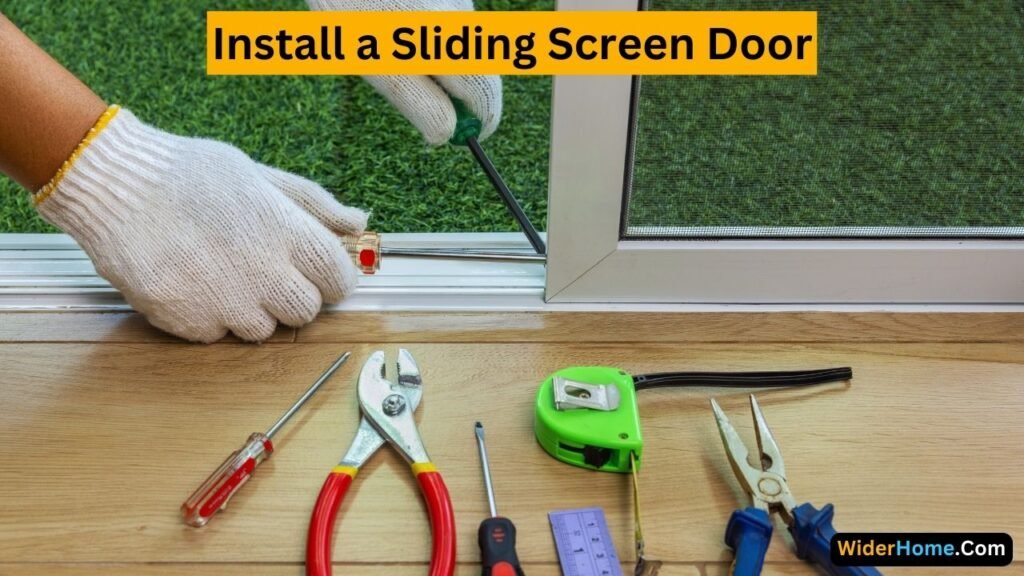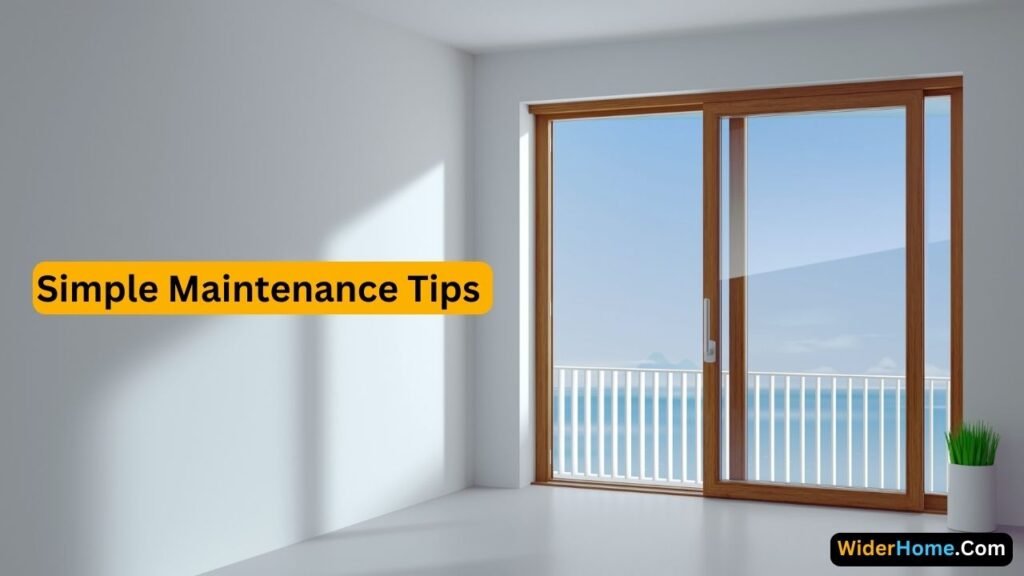How to Install a Sliding Screen Door?

More airflow through a sliding screen door improves ventilation and helps you maintain a more comfortable interior atmosphere. Insects and trash are kept out of the house by this barrier as well.
In an effort to ensure that the reader is aware of the significance of how to install a sliding screen door and what to anticipate throughout the installation process, the introduction tries to set the stage for the thorough instructions that follow.
Importance of Installing a Sliding Screen Door
The installation of a sliding screen door is essential for a number of reasons. This is achieved in two ways. First of all, it allows fresh air to enter your home, lowering the interior temperature and requiring less air conditioning.
Furthermore, it keeps insects like mosquitoes and flies outside so you can enjoy the outdoors without worrying about bugs.
Thirdly, putting an extra layer of security in place makes your property more resistant to intruder attacks. Additionally, a sliding screen door can improve the look of your house and give it a welcoming, airy vibe.
An all-around useful addition that can enhance your home’s health, comfort, and safety is a sliding screen door.
Materials and Tools Required to Install a Sliding Screen Door

To install a sliding screen door, the right supplies and equipment are needed. The essentials and their justifications are enumerated below:
- Sliding Screen Door Kit: This kit comes with everything you need to install a screen door, including the frame and screen. These parts are specifically designed to work together.
- Phillips and flat-head screwdrivers: A screwdriver (flat-head and Phillips design) is needed to tighten and loosen fasteners. You’ll need both types of screws because not all screws have the same head.
- Bits and Drilling: You must use drill and drill bits to make pilot holes for the screws in order to ensure a straight and secure screw installation.
- Measuring Tape: You can record the locations of the screw holes and ascertain the precise dimensions of your doorway with the aid of a measuring tape.
- Level: This device ensures that your doors’ tracks are perfectly horizontal, enabling smooth operation.
- Pencil: A pencil is a necessary tool for recording screw hole locations and dimensions.
- Pliers: These can be used to adjust the door rollers to ensure smooth functioning.
- Hacksaw (if trimming is required): A hacksaw can be used to cut any overly long doors or tracks to the appropriate length.
For a perfect fit and simple operation, your sliding screen door must be installed correctly, which requires a few supplies and tools.
How To Install a Sliding Screen Door | Step-by-Step

These detailed instructions will assist in making installing a sliding screen door easier. Because every step is thoroughly and clearly described, even inexperienced do-it-yourselfers may follow along with ease. The components of each step are decomposed as follows:
Step 1: Unbox the Sliding Screen Door Kit
In this initial step, every component needs to be removed from the box and placed. Ensuring all required parts are there before starting the installation procedure is essential to avoid delays and interruptions.
Step 2: Prepare the Doorway
Screen door installation requires preparation of the doorway. This includes checking it for damage and clearing any debris from the door track. The screen door has to have the necessary repairs done in order for it to function properly.
Step 3: Assemble the Door
The sliding screen door frame is put together in accordance with the manufacturer’s instructions. For the door to be stable and functional, every part is securely fastened and positioned as intended.
Step 4: Install the Top Track
The top track should be installed on the upper frame of the doorway. The only way to ensure that the track is completely horizontal is to use a level. Before the track is secured in place, the screw holes need to be identified and drilled.
Step 5: Install the Bottom Track
The top track and bottom track must also be positioned and aligned. The track is fixed into place by drilling pilot holes and marking the screw holes. The top and bottom tracks must be properly aligned for the door to operate effectively.
Step 6: Adjust the Door Rollers
The adjustment screws on the door’s rollers may need to be changed in order to preserve exact alignment and smooth sliding over the rails. Pliers can be required at this stage to make some modifications.
Step 7: Install the Sliding Screen Door
To slide the door’s top rollers into the top track, it must be raised at this point. The bottom rollers should align with the bottom track once the door has been gently lowered into place. Test the door by sliding it back and forth to make sure it works as intended.
Step 8: Final Adjustments and Finishing Touches
Any last-minute adjustments are made to guarantee that the door locks properly and operates without a hitch. For a clean, polished finish, additional material from the door or rails can be sawed off if necessary.
You may improve the functionality and aesthetic appeal of your house and guarantee a faultless installation by adhering to these rules.
Common Problems and Solutions

Although installing a sliding screen door may be straightforward, there are a few typical issues that could arise. Take into account the following potential problems and their solutions to ensure a seamless installation:
Misaligned Tracks
Problem: After the top and bottom tracks are put in, the door does not slide smoothly.
Solution: Use a level to make sure both tracks are aligned. To align the tracks if they are not exactly parallel, loosen the screws on one track and move them about until they do. After tightening the screws once more, check the door’s movement.
Difficulty in Sliding the Door
Problem: It’s difficult to move the sliding screen door along the tracks.
Solution: Make sure there is no debris on the tracks and that they are clean. If needed, remove any filth with a moist cloth or hoover. Additionally, make sure the screws on the door roller are not overly tight or loose by checking and adjusting them. Smoother sliding can also be facilitated by lightly lubricating the tracks using silicone-based lubricant.
Gaps around the Door
Problem: There is a slight gap between the sliding screen door and the door frame.
Solution: The answer is to make sure the door fits your doorway properly in terms of size. To guarantee correct alignment and contact with the rails, adjust the door rollers. If gaps still exist, install door sweeps or weatherstripping to seal the gaps and keep drafts and insects out.
Door Does Not Lock Properly
Problem: There is a problem with the sliding screen door’s latch or lock.
Solution: Verify that the striker plate and lock mechanism are properly aligned. It could be necessary to use the roller adjustment screws to realign the door or move the striker plate. If the lock isn’t working properly, try changing it or refer to the manufacturer’s troubleshooting instructions.
Screen Damage during Installation
Problem: When the door is put onto the tracks, the screen is ripped or broken.
Solution: When installing the screen door, handle it cautiously and don’t use too much force. There are screen repair kits available in case the screen becomes damaged. The tools needed to replace the screen mesh are included in these kits. In order to replace or repair the damaged screen, follow the kit’s instructions.
Track Obstruction
Problem: The track has obstacles that make it difficult for it to slide smoothly.
Solution: Check both rails for damage or impediments the whole way along. Take away any obstructions and inspect the track for any bends or dents. If any deformities are discovered, use pliers or a similar tool to gently straighten them.
Incorrect Door Orientation
Problem: The screen is put on the incorrect side of the door.
Solution: To make sure the door alignment is proper, consult the manufacturer’s directions. It could be necessary to take the door apart and rebuild it properly, making sure the screen faces the intended direction if it is inverted.
By addressing these common issues with practical solutions, you can increase the longevity and success of your sliding screen door installation while also enhancing the security and comfort of your house.
Simple Maintenance Tips For Sliding Screen Door

It’s easy to maintain the condition of your sliding screen door if you adhere to these basic guidelines:
Clean Regularly
Cleaning of the rollers and tracks should be done often. The motion of the door may be impeded by dust and debris. The tracks can be cleaned with a damp cloth or by vacuuming them. Door sliding can be enhanced with a tiny bit of silicone lubrication.
Check the Rollers
Make sure you regularly inspect your rollers to keep an eye out for any wear and tear or broken ones. If they’re not working well, it won’t be easy to open and close the door. If required, replace the rollers and tighten any loosened screws. New rollers are available at almost all hardware stores.
Lubricate Moving Parts
Oil with a silicone basis should be used to lubricate the moving components of the door, including the tracks, rollers, and hinges. Everything will proceed more easily as a result of this. Make sure to remove any extra oil to prevent dirt buildup.
Fix the Screen
Check for rips or holes in the screen. They might provide access to insects. You can mend any damage you detect with a screen repair kit that you can get from a home improvement store. These kits usually include patches or new mesh to replace the previous screen.
Keep the Door Aligned
Every now and again, the door may veer off course and slide poorly. To fix this, move the door back and forth to check its alignment. Use the screws to adjust the height of the rollers if they become stuck. It will slide more easily as a result.
Replace Weather Stripping
Examine the area around the door’s edge to see if the weather stripping is worn out. This will keep out cold air, dampness, and insects. Should any damage be noticed, have the weather stripping replaced.
Also Read: How Garage Door Works?
FAQs
Can you install a screen door yourself?
Yes, you can install a screen door yourself! Take a measurement of the door frame. Establish what size your screen door should be. The next step is to gather tools such as a screwdriver and drill. Take out and undo any outdated screen doors. After fastening the door’s hinges to the frame, insert the mounting brackets to keep it in place. Make the last-minute tweaks to the door to ensure proper operation.
Can I add a sliding screen door to an existing one?
You may upgrade an existing door to a sliding screen door; this is the answer! Measure the dimensions of your existing door frame before buying a screen door. Next, get a sliding screen door kit at a home improvement store. As directed by the kit, install the screen door and attach the tracks. Tracks and rollers should be adjusted to guarantee smooth door sliding. It’s a simple way to let fresh air in without inviting bugs inside.
How do you keep a sliding door on track?
To keep a sliding door on its tracks and clear of dirt and debris, clean the door tracks on a regular basis. Use a brush or hoover to get rid of any accumulation. To ensure smooth movement, lubricate the tracks with a silicone-based product. In order to preserve the door’s alignment, examine the rollers for wear and adjust as needed. Tighten any loose screws to stop the door and track from shaking. Regular maintenance will help a sliding door slide smoothly.
My sliding screen door isn’t gliding smoothly. How can I fix this issue?
- Clean the Tracks: Remove any dirt or debris from the door tracks with a brush or hoover.
- Lubricate the Tracks: Use a silicone-based spray lubricant to improve the smoothness of movement in the tracks.
- Inspect the Rollers: Check the rollers for signs of deterioration or wear. Should they seem worn out, get new ones.
- Adjust the Rollers: If the rollers are in perfect working order, make sure the door is correctly positioned within the track by adjusting the height screws.
- Tighten Screws: Make sure all of the screws on the door and track are tight to improve sliding and reduce wobbling.
- Check for Obstacles: Make sure the track and path of the door are clear.
- Handle Gently: Carefully open and close the door to ensure continuous smooth operation and prevent further damage.
How often should I clean my sliding screen door tracks?
It would help if you cleaned the tracks at least once a month since dirt and debris might obstruct the mobility of your sliding screen door when they accumulate.
What type of lubricant should I use on my door?
The moving part of your sliding screen door should be lubricated with silicone. Grease accumulation is prevented by silicone-based lubricants through silicone seamless functioning.
Do the rollers need replacement?
Regularly inspect the rollers for wear or damage. If the rollers begin to exhibit wear and tear or if opening and closing the door becomes challenging, they should probably be replaced. If the rollers are functioning properly, then you might also benefit from fixing any loose screws.
What should I do if my sliding screen door gets stuck?
Make sure there is no dirt in the sliding screen door tracks before moving further, and clean them if necessary. Next, examine the alignment and condition of the roller. The rollers’ height screws can be adjusted to enable smooth sliding and door realignment.
Conclusion
Sliding screen door maintenance and troubleshooting don’t have to be difficult. Maintaining a regular maintenance program and keeping an eye out for common problems like worn rollers, misaligned tracks, or damaged screens will help to keep your door operating smoothly and effectively. The longevity of your sliding screen door and the security and comfort of your house will both rise with regular maintenance. If the door is handled properly, the moving parts are greased, the tracks are cleaned, and worn-in areas are examined, there may be a significant difference. Adopt these habits to reap the benefits of a sliding screen door that won’t need to be maintained for many years.
